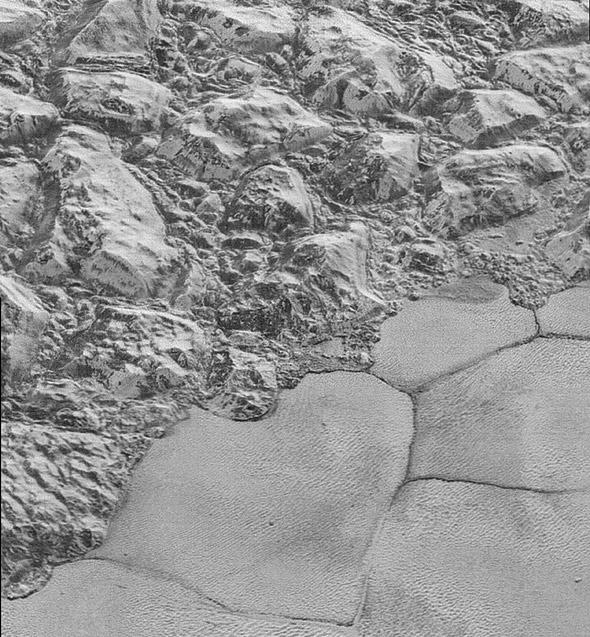NASA just released new photos of Pluto taken from the closest approach of the New Horizons spacecraft, and they are likely to be the highest resolution images we’ll see of the icy world’s surface! These were taken from a distance of about 12,500 kilometers, and have a resolution of a staggering 80 meters.
First, here’s an animation showing the location of the images taken, ending with a flyover of a strip about 80 kilometers across and 800 long. It’s amazing.
Two of the shots in particular are worth looking into more closely. The first is something both utterly alien and eerily familiar: a mountainous shoreline.

Photo by NASA/JHUAPL/SwRI
This shows the northwest edge of Sputnik Planum, the left lobe of the huge heart-shaped region on Pluto. There’s a lot to see here!
The scene almost looks like it could be a satellite shot of Earth, off the Greenland or Alaskan coast. There are three major differences, though: It was taken 5 billion kilometers from Earth, the frozen sea there is actually frozen nitrogen, and—perhaps most astonishingly—those mountains aren’t rock, they’re frozen water!
Pluto is so cold water ice is hard as rock, and can form mountains thousands of meters tall. The bright plain was probably lower elevation terrain which filled with nitrogen, which is much less rigid than water at these temperatures. It can flow like glaciers do on Earth. So what you’re seeing there is a shoreline! It really looks like one, too, with the nitrogen ice meeting the highlands at a “constant sea level.”
The ripples in the ice may be due to sublimation—the feeble sunlight causing the nitrogen to go directly from solid to gas. It almost looks like transverse dunes, though that seems really unlikely to my (admittedly unexpert) brain. I do love how that one segment of ice below center is heart-shaped: It’s like a mini version of the plain itself. A heart in a heart.

Photo by NASA/JHUAPL/SwRI
This image shows craters to the north of the plains. This is fascinating. The region is white, meaning it’s probably coated in nitrogen ice. But the subsurface material is darker (a mix of rock and water ice, or ancient tholin-stained material?), and that gets exposed when an object impacts the surface and excavates material.
But it’s more complicated than that, isn’t it? Many of the craters are coated white, so more nitrogen may have found its way in after the impact events. You can see how the rims are darker, and the one big crater above center is terraced, with a dark inner rim inside the outer rim.
My favorite part here is the crater below center. It looks like there was either a second impact or a rim collapse just below it. It’s very dark inside, which means very little ice is coating the inside (though you can see some coating the wall on the left). But look all around it: There’s a darkish envelope outside it. To my eye that looks like it gently slopes downward toward the crater, though that might be an illusion.
I can speculate a lot about this; if the outer part really is a gentle downhill slope leading to the crater, it could be where the ground subsided (sank) after impact. That might hint at what’s under the surface there—less well-packed and/or softer material.
Or I may be completely wrong! It’s fun to grind through ideas when looking at these images, but one thing I’ve learned very well when it comes to surface geology on planets (including our own) is that things can be very different than how they look. Not everything happens at once, and subsequent events can reveal or hide previous ones. Or both! I enjoy playing with speculation, but I know better than to dig in. I’ll leave that to the planetary scientists and other experts.
But whatever is happening in these images, remember this: They show a world billions of kilometers away, one we didn’t see up close until just this very year, and which will keep scientists gleefully busy for years.
And I’ll remind you we haven’t even received half the data from New Horizons yet! There’s still much, much more to see.